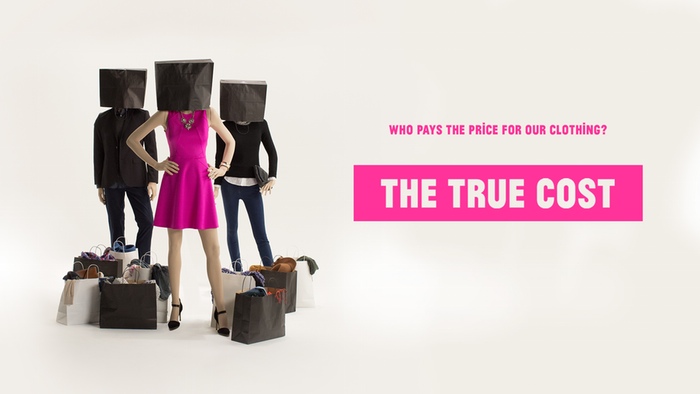So, my simple living fashionistas – what shall we do?
My darling daughter just told me about a fashion documentary that she watched, called The True Cost. Download it for free at http://truecostmovie.com.
After watching it, I will now think twice about where and what I buy. Until this documentary, I prided myself on getting adorable clothes on sale at some of the large brand stores. For example, just this summer I bragged about the fabulous linen shirts I scored that came in oh-so-interesting colors, originally $60 and I got on sale for $15. In years past, I thought that the way to look good and spend less on clothes was to buy just a couple of high-quality and more expensive items in classic styles. My theory was that these classic, higher quality styles would last and last.
But that was before the phenomenon of fast fashion.
What happened is that fast-fashion has created such hyper-fast fashion changes that you’re practically out of style when you walk out the door of the store – any store – upscale store, discount store, whatever store.You’ll understand fast fashion in more detail when you watch the documentary, but for now – its a term that describes brands like H&M, Zara and Forever 21. They imitate the current designer brands and figured out how to make them for super, super cheap, and also crank them out in record time – hence the term, fast fashion.
The other thing they’ve done is amp up the fashion seasons. Used to be that there were four fashion seasons, spring, summer, fall and winter. But in order to create increased consumer desire for more clothes, the fast fashion brand Zara speeded up the seasons, so that they now have mini seasons every week. 50 – 100 new micro seasons a year is the new normal. Once these fast fashion brands started raking in ginormous profits (H&M is now the most profitable fashion brand in the history of fashion earning $22 billion a year), other large brands took notice and followed suit.
That’s why clothing in general has gotten cheaper and cheaper over the years. And the cool thing is – remember when you had to shop at tacky discount stores when you wanted to save money on clothes? And remember how, in shopping at these places you had to accept looking less than fashionable? No more. Now you can get super cute, super fashion forward clothes for even less than you used to spend at the tacky discount stores. In fact, when you take advantage of the sales at these big brands now – you can get them for less than you can buy clothes at a thrift store.
Who could resist this?
Not me, and not millions of female consumers in developed countries around the globe.
But Houston, we have a problem.
Most of us never thought for one second about how these cute and super duper cheap clothes came to be, did we?
And this is what The True Cost is about.
Heres what I learned by watching The True Cost. In order to sell my cute linen shirt for $15, the brands have to produce that shirt for even cheaper. How? By manufacturing mind-bogglingly vast amounts of cheap fabric, and by getting the labor for rock bottom cheap. Remember when that big sewing factory collapsed in Dhaka, India in 2012, killing over 100 of the workers? Remember how we Westerners were in an uproar? Remember how our uproar caused the big clothing brands to promise never to use child labor, and never to have their sewers work in sweatshop conditions ever again? Not on my watch, they said.
But in reality, nothing has changed. If the big fashion brands are going to compete with each other on cost – they have to produce the clothes for cheap and cheaper. So they squeeze the Bangladeshi and other factory owners on price. The factory owners are desperate to get the business, so who do they squeeze? The workers, who earn somewhere between $2 and $3 a day.
Because everyone is squeezed – its easy to see why the Dhaka factory owners ignored the safety warnings before the building collapsed. Funny thing is – the year after that factory collapse was the most profitable year ever for the big fashion brands, earning them almost $3 trillion globally.
Another way the big fashion brands have gotten around the issue of sweat labor and horrible working conditions is by not directly hiring the workers. In Cambodia, another high volume clothing manufacturing region, the state – not the fashion brands – employs the workers. So when a fast-fashion or other big brand has their clothing made there – they can safely say that they are not employing anyone working under sweat shop conditions because they are, in fact, not employing anyone. Its the same as in India. These countries are so poor and so desperate to get the manufacturing contracts that they squeeze the daylights out of the workers. When Cambodian workers tried to protest in the streets not long ago, the government sprayed them with bullets and killed a number of the protestors. The government simply cant afford to pay the workers more because then theyd lose the coveted manufacturing contracts.
The Bangladeshi workers tried to organize in order to earn a little more and have safer working conditions, but some of the ringleaders were locked in a room and beaten. Again, the factory owners couldn’t afford to lose the contracts.
A natural thought comes to mind. Well, $2 or $3 a day is better than begging in the streets and its a way out of poverty, isnt it?
The True Cost response is this: The above is true, but that doesnt mean we need to treat workers in such inhumane ways, it doesn’t mean we need to work them literally to death, and it doesnt mean we need to trash the environments in which they live and raise their children. There is a middle ground – so lets make it happen.
Lets look now at how the fabric is made so cheaply. Most clothes are made from cotton. One of the biggest cotton producers in the world is in Punjab, India. In order to grow the cotton faster and cheaper, it is heavily sprayed with chemicals, supplied by Monsanto Corporation. There are vast acres being sprayed, so what happens? More and more kids are born severely handicapped in Punjab. More adults are getting cancer. And Monsanto? Read about how Monsanto has indebted poor farmers in India to them, and why one farmer commits suicide in India every 30 minutes because they cannot pay their debts to Monsanto: http://www.globalresearch.ca/the-seeds-of-suicide-how-monsanto-destroys-farming/5329947
But the problem isnt limited to Punjab, India. Its also in the state of Texas, USA. Texas produces more cotton than any other state in the U.S. Chemicals are heavily sprayed over vast acres of land in the cotton growing regions, and consequently, a rise in cancer there, too. The problem is not limited to cotton clothes. How about that adorable leather jacket or purse you bought, or the way-cute leather shoes you scored for super cheap?
People want cheap leather, so big fashion brands give it to us. How? By manufacturing in places with cheap labor and either lax or no environmental regulations. Whats the environment got to do with this? In order to turn a cow hide into a leather jacket, one of the chemicals used is chromium. Because there is such a huge demand for cute and cheap leather worldwide, thats a whole lot of chromium. In certain regions in India where much of the worlds leather is produced, their rivers are polluted with chromium, the groundwater is contaminated with chromium, and adults and children are increasingly disfigured.
Back to my linen shirt. I remember when buying linen, cashmere or leather were big deals. They were made well and they cost a lot. If you bought one, it was very special and you probably only had one. They were made in places like the U.S. or Italy. So now I understand how things shifted. We live in a consumer culture and are led to believe we need all of these things, and the manufacturers give them to us. Its a vicious cycle, isnt? Not only that – but theres not much thats special any more, in the way of clothes. When you have 10 linen shirts or 5 leather jackets or 20 purses – whats special?
I could go on, but you get the idea. There are many things you can do, and there are brands and designers who are, in fact, doing the right thing.
Heres a link to some of those brands: http://truecostmovie.com/learn-more/buying-better/
And here are some quick tips from The True Cost website:
5 TIPS FOR SHOPPING SMARTER – see the full list here: http://truecostmovie.com/learn-more/buying-better/
1) Will you wear it 30 times? If not, dont buy it.
2) Break the cycle. Just because the fast fashion brands concocted 50 – 100 micro seasons a year, you dont need to buy into it.
3) Spread your fashion dollars. Look for brands that run rigorous fair-trade standards.
4) Detox your wardrobe. Fashion is the worlds second most polluting industry after oil. 10 percent of the worlds biggest fashion brands have committed to phasing out toxic substances. See who, here: http://truecostmovie.com/learn-more/buying-better/
5) Join the fashion revolution. Check out fashionrevolution.org.






6 comments
Love it! I found a few great brands on the True Cost website, and have previously bought things from Everlane, Cuyana and Claire V, all of which are great. I also found some adorable shoes on Zady.com and Nisolo.com.
XOXO
Where does the “sisterhood” i.e. women’s movements stand on this issue? What is the UN’s policy on this issue.
You watched a shallow propaganda film that deliberately distorts reality to make a point that appeals to Western guilt. Yuck.
There are a LOT of false assumptions here.
First, you’re assuming that the less expensive brands result in people who are paid less than more expensive brands. This is false. The same factories often produce for both low and high-end brands–often using the same materials! There are sometimes differences in the level of finish and quality-control, though this is far from assured. There is, of course, a difference in logos and labels, for sure!
Second, you’re assuming that the international market sets local labor prices. It doesn’t. The Bangladeshi factory owners pay the prevailing wage for the local job market, which is set by competition among thousands of different occupations for the local labor pool. Which country gets the contract depends on the international market; what local workers are paid depends on the local market.
Third, you have a backwards view of child labor. Child labor occurs because families depend on children to at least partly support themselves. Not hiring children in that kind of market mean that the children starve. The answer to child labor is the education of women. This means that families need to feel incentives to send girls to school rather than have them labor at home or elsewhere, and adult education for women needs to be a priority. I contribute to charities in Haiti, Guatemala, and India that have this goal for this reason. My contributions will bring 800 illiterate Indian women to reading at a 5th grade level at the end of a year this year alone.
Fourth, the supposed solutions in the film are no such thing because the producers have no grasp of economics. Establishing minimum international standards through treaties and international inspectors (in countries with terrible human rights records, bribery is rampant) will be key to speeding up the improvement of working conditions and pollution standards, allowing an international “level playing field” for bidders. One of the reasons that China and Bangladesh, for instance, have been able to produce things so cheaply is by having a complete disregard for both safe working conditions and for pollution. This is the economic concept of moral hazard. By moving the true costs of producing an item (which includes the costs caused by whatever pollution is produced) back onto the cost of the item itself, we prevent essentially subsidizing clothes bought in the US or France with cost of the cancer that people get in a city in Vietnam.
Fifth, you’re assuming that the “miniseasons” are something that’s followed in terms of the most “in” styles by more than 2% of the population. It’s not. Places with ultra-high turnover turn a profit with their sense of urgency, not the fact that people feel like they have to spend money to stay in style. In fact, trends in women’s clothing have become so brief and fleeting and have gone so many different directions at the same time that women have felt far LESS of a need over the last 15 years to change their wardrobes. Back as far as the 1860s, the wealthy could tell one season’s dresses from the next through distinct and large changes in style. By 1906, the styles of 1903 in high fashion would be glaringly out of place at a ball. Today, though, if we took the red carpet at the Academy Awards, most dresses from the past 10 or 15 years would look entirely in style if plopped onto it today. The jeans of the 1960s were bellbottoms. 1970s, tight, dark, straight-legs. 1980s, baggy and increasingly acid-washed. 1990s, acid-washed, high-waisted, straigh-legged. But starting in the 2000s…what? We had the hip-hugger boot-legged craze and the skinny jean craze, but if you had six fashionable girls in their favorite jeans lined up together, there’s a chance that not one pair would be the same color, cut, and waist height.
All this has been reflected in a stagnation of women’s spending on fashion because they don’t feel like they have to spend the money now, while men’s spending has actually trended upwards as men’s clothing is still more uniform-like.
Anyway, this is all to say…if you want to make a difference, then BUY LESS, especially new, and donate to causes that are actually making an impact. I make a list of everything that I will need each year, clothing-wise, and I shop from that. It really simplifies my shopping and prevents over-consumption. And I avoid anything that’s extremely trendy! I prefer to wear out my clothes BEFORE they go out of style.
BTW, educating women ends child labor in a number of ways:
1. Educated women increase the wealth of their families. Most poor women in the world do some form of money-generating labor. More educated women make more money for their families. They also spend it better and save better.
2. Educated women generally marry later and have better marriages. Because they are worth more with education, women are able to put off marriage for more advantageous matches, and they are less likely to marry men who are abusive or unable to support a family.
3. Educated women have fewer children. Because they marry later and understand birth control, they see having children as something they can either choose or take steps to avoid. Because they feel like they can provide better for themselves and their family through their greater economic resources and also through their understanding of hygiene, they don’t feel like they need a lot of kids to make sure that some survive childhood to support them in their old age. Because they value education, they see children as something that you put money into (at least for most of his childhood) rather than as an attempt to get more hands to work as quickly as possible. All of this means that they don’t have more kids than the adults in the family are able to provide for.
The result of all these factors is that maternal education is the SINGLE strongest association with child labor–ESPECIALLY, interestingly enough, in cultures that traditionally give women very little autonomy. The education of women also ends child slavery and greatly diminishes other forms of human trafficking, which is a rampant problem in many parts of the world.
Thanks for the article, I agree with all you wrote 🙂
Thanks for direction on where to go now that we are aware of what’s happening.
FYI that the Dhaka building collapse killed over 1100 people….. Not a hundred.
I shared my reaction to the film here, if you’re interested 🙂
http://www.toomanylattes.com/blog-1/2015/9/22/the-true-cost-of-my-conspicuous-consumption